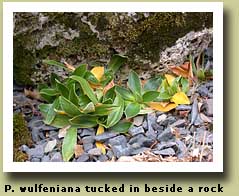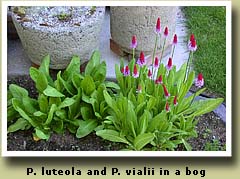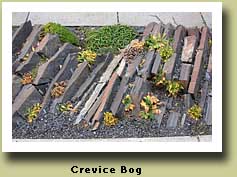|
|
See also : Growing from Seed, Growing from Leaves. Growing primulas depends on where you garden. What follows is a description about how I grow them in my garden in Calgary. Click here for more about my garden. First it’s important to know that even primulas which live in drier climates are still growing in moist microclimates. Primulas do not tolerate drying out at the root. Almost three-quarters of all primula species grow in the Himalayas. The rest are scattered through Europe, non-Himalayan areas of China, Central Asia, Caucasus, North America, Siberia, Japan, and a few in SE Asia, Arabia and one species (P. magellanica) in South America. That means that the majority of primulas experience monsoon conditions. This is difficult to simulate in an open garden, though it may be done in a greenhouse with misting systems. Instead, it is best to concentrate on giving primulas moist conditions. There are many primulas which will grow in ‘regular’ garden soil. My soil is prairie clay which I have tried to improve with compost, peat and grit. Primulas do best when given an easy root run so make the soil loose. My soil is alkaline, but the primulas don't seem to care. Some of my primula beds are located in part shade with an Eastern exposure or in the dappled shade of large trees. Primulas are heavy feeders, so the addition of compost or fertilizer to your soil is recommended. If you are a beginner try: polyneura, veris, elatior, denticulata, auricula, frondosa, and cortusoides in these garden conditions.
Many smaller primulas do well in scree or crevice style rock beds. The key here is to tuck plants beside rocks or in the shelter of larger plants to provide a cool, moist root run and some protection from intense sun. The parts of my scree which I grow primulas in are either in part shade, or on the North and East side of the mound. Primulas that grow nicely in these beds are the smaller ones including: wulfeniana, minima, latifolia, glaucescens, and scandinavica.
Copyright Pam Eveleigh ©2003-2004, All Rights Reserved |


